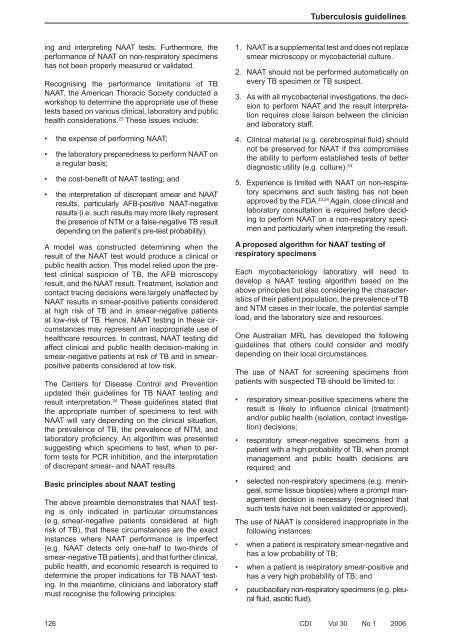PDF file - Department of Health and Ageing
PDF file - Department of Health and Ageing
PDF file - Department of Health and Ageing
You also want an ePaper? Increase the reach of your titles
YUMPU automatically turns print PDFs into web optimized ePapers that Google loves.
Tuberculosis guidelines<br />
ing <strong>and</strong> interpreting NAAT tests. Furthermore, the<br />
performance <strong>of</strong> NAAT on non-respiratory specimens<br />
has not been properly measured or validated.<br />
Recognising the performance limitations <strong>of</strong> TB<br />
NAAT, the American Thoracic Society conducted a<br />
workshop to determine the appropriate use <strong>of</strong> these<br />
tests based on various clinical, laboratory <strong>and</strong> public<br />
health considerations. 23 These issues include:<br />
• the expense <strong>of</strong> performing NAAT;<br />
• the laboratory preparedness to perform NAAT on<br />
a regular basis;<br />
• the cost-benefi t <strong>of</strong> NAAT testing; <strong>and</strong><br />
• the interpretation <strong>of</strong> discrepant smear <strong>and</strong> NAAT<br />
results, particularly AFB-positive NAAT-negative<br />
results (i.e. such results may more likely represent<br />
the presence <strong>of</strong> NTM or a false-negative TB result<br />
depending on the patient’s pre-test probability).<br />
A model was constructed determining when the<br />
result <strong>of</strong> the NAAT test would produce a clinical or<br />
public health action. This model relied upon the pretest<br />
clinical suspicion <strong>of</strong> TB, the AFB microscopy<br />
result, <strong>and</strong> the NAAT result. Treatment, isolation <strong>and</strong><br />
contact tracing decisions were largely unaffected by<br />
NAAT results in smear-positive patients considered<br />
at high risk <strong>of</strong> TB <strong>and</strong> in smear-negative patients<br />
at low-risk <strong>of</strong> TB. Hence, NAAT testing in these circumstances<br />
may represent an inappropriate use <strong>of</strong><br />
healthcare resources. In contrast, NAAT testing did<br />
affect clinical <strong>and</strong> public health decision-making in<br />
smear-negative patients at risk <strong>of</strong> TB <strong>and</strong> in smearpositive<br />
patients considered at low risk.<br />
The Centers for Disease Control <strong>and</strong> Prevention<br />
updated their guidelines for TB NAAT testing <strong>and</strong><br />
result interpretation. 24 These guidelines stated that<br />
the appropriate number <strong>of</strong> specimens to test with<br />
NAAT will vary depending on the clinical situation,<br />
the prevalence <strong>of</strong> TB, the prevalence <strong>of</strong> NTM, <strong>and</strong><br />
laboratory pr<strong>of</strong>i ciency. An algorithm was presented<br />
suggesting which specimens to test, when to perform<br />
tests for PCR inhibition, <strong>and</strong> the interpretation<br />
<strong>of</strong> discrepant smear- <strong>and</strong> NAAT results.<br />
Basic principles about NAAT testing<br />
The above preamble demonstrates that NAAT testing<br />
is only indicated in particular circumstances<br />
(e.g. smear-negative patients considered at high<br />
risk <strong>of</strong> TB), that these circumstances are the exact<br />
instances where NAAT performance is imperfect<br />
(e.g. NAAT detects only one-half to two-thirds <strong>of</strong><br />
smear-negative TB patients), <strong>and</strong> that further clinical,<br />
public health, <strong>and</strong> economic research is required to<br />
determine the proper indications for TB NAAT testing.<br />
In the meantime, clinicians <strong>and</strong> laboratory staff<br />
must recognise the following principles:<br />
1. NAAT is a supplemental test <strong>and</strong> does not replace<br />
smear microscopy or mycobacterial culture.<br />
2. NAAT should not be performed automatically on<br />
every TB specimen or TB suspect.<br />
3. As with all mycobacterial investigations, the decision<br />
to perform NAAT <strong>and</strong> the result interpretation<br />
requires close liaison between the clinician<br />
<strong>and</strong> laboratory staff.<br />
4. Clinical material (e.g. cerebrospinal fl uid) should<br />
not be preserved for NAAT if this compromises<br />
the ability to perform established tests <strong>of</strong> better<br />
diagnostic utility (e.g. culture). 24<br />
5. Experience is limited with NAAT on non-respiratory<br />
specimens <strong>and</strong> such testing has not been<br />
approved by the FDA. 23,24 Again, close clinical <strong>and</strong><br />
laboratory consultation is required before deciding<br />
to perform NAAT on a non-respiratory specimen<br />
<strong>and</strong> particularly when interpreting the result.<br />
A proposed algorithm for NAAT testing <strong>of</strong><br />
respiratory specimens<br />
Each mycobacteriology laboratory will need to<br />
develop a NAAT testing algorithm based on the<br />
above principles but also considering the characteristics<br />
<strong>of</strong> their patient population, the prevalence <strong>of</strong> TB<br />
<strong>and</strong> NTM cases in their locale, the potential sample<br />
load, <strong>and</strong> the laboratory size <strong>and</strong> resources.<br />
One Australian MRL has developed the following<br />
guidelines that others could consider <strong>and</strong> modify<br />
depending on their local circumstances.<br />
The use <strong>of</strong> NAAT for screening specimens from<br />
patients with suspected TB should be limited to:<br />
• respiratory smear-positive specimens where the<br />
result is likely to infl uence clinical (treatment)<br />
<strong>and</strong>/or public health (isolation, contact investigation)<br />
decisions;<br />
• respiratory smear-negative specimens from a<br />
patient with a high probability <strong>of</strong> TB, when prompt<br />
management <strong>and</strong> public health decisions are<br />
required; <strong>and</strong><br />
• selected non-respiratory specimens (e.g. meningeal,<br />
some tissue biopsies) where a prompt management<br />
decision is necessary (recognised that<br />
such tests have not been validated or approved).<br />
The use <strong>of</strong> NAAT is considered inappropriate in the<br />
following instances:<br />
• when a patient is respiratory smear-negative <strong>and</strong><br />
has a low probability <strong>of</strong> TB;<br />
• when a patient is respiratory smear-positive <strong>and</strong><br />
has a very high probability <strong>of</strong> TB; <strong>and</strong><br />
• paucibacillary non-respiratory specimens (e.g. pleural<br />
fluid, ascitic fluid).<br />
126 CDI Vol 30 No 1 2006
















